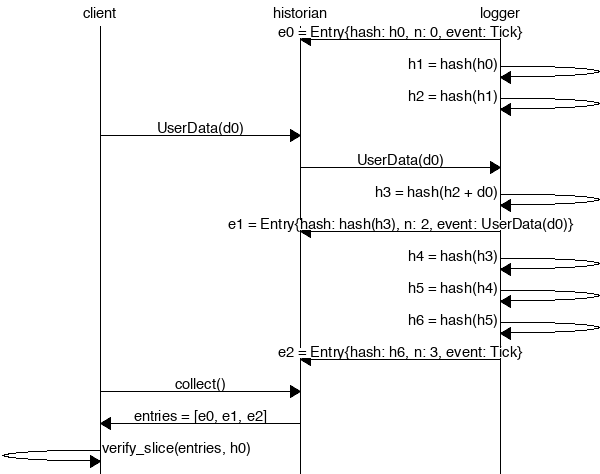Unlike a Discovery event, a Claim event associates a public key with a hash. It's intended to to be used to claim ownership of some hashable data. For example, a graphic designer could claim copyright by hashing some image they created, signing it with their private key, and publishing the hash-signature pair via the historian. If someone else tries to claim it as their own, the designer can point to the historian's log as cryptographically secure evidence that the designer's copy existed before anyone else's. Note there's nothing here that verifies the first claim is the actual content owner, only that the first claim almost certainly happened before a second. |
||
|---|---|---|
| diagrams | ||
| src | ||
| .codecov.yml | ||
| .gitignore | ||
| .travis.yml | ||
| Cargo.toml | ||
| LICENSE | ||
| README.md | ||
README.md
Silk, a silky smooth implementation of the Loom specification
Loom is a new achitecture for a high performance blockchain. Its whitepaper boasts a theoretical
throughput of 710k transactions per second on a 1 gbps network. The specification is implemented
in two git repositories. Reserach is performed in the loom repository. That work drives the
Loom specification forward. This repository, on the other hand, aims to implement the specification
as-is. We care a great deal about quality, clarity and short learning curve. We avoid the use
of unsafe Rust and write tests for everything. Optimizations are only added when
corresponding benchmarks are also added that demonstrate real performance boosts. We expect the
feature set here will always be a ways behind the loom repo, but that this is an implementation
you can take to the bank, literally.
Usage
Add the latest silk package to the [dependencies] section
of your Cargo.toml.
Create a Historian and send it events to generate an event log, where each log entry is tagged with the historian's latest hash. Then ensure the order of events was not tampered with by verifying each entry's hash can be generated from the hash in the previous entry:
extern crate silk;
use silk::historian::Historian;
use silk::log::{verify_slice, Entry, Event, Sha256Hash};
use std::thread::sleep;
use std::time::Duration;
use std::sync::mpsc::SendError;
fn create_log(hist: &Historian) -> Result<(), SendError<Event>> {
sleep(Duration::from_millis(15));
hist.sender.send(Event::Discovery(Sha256Hash::default()))?;
sleep(Duration::from_millis(10));
Ok(())
}
fn main() {
let seed = Sha256Hash::default();
let hist = Historian::new(&seed, Some(10));
create_log(&hist).expect("send error");
drop(hist.sender);
let entries: Vec<Entry> = hist.receiver.iter().collect();
for entry in &entries {
println!("{:?}", entry);
}
// Proof-of-History: Verify the historian learned about the events
// in the same order they appear in the vector.
assert!(verify_slice(&entries, &seed));
}
Running the program should produce a log similar to:
Entry { num_hashes: 0, end_hash: [0, ...], event: Tick }
Entry { num_hashes: 2, end_hash: [67, ...], event: Discovery(3735928559) }
Entry { num_hashes: 3, end_hash: [123, ...], event: Tick }
Proof-of-History
Take note of the last line:
assert!(verify_slice(&entries, &seed));
It's a proof! For each entry returned by the
historian, we can verify that end_hash is the result of applying a sha256 hash to the previous end_hash
exactly num_hashes times, and then hashing then event data on top of that. Because the event data is
included in the hash, the events cannot be reordered without regenerating all the hashes.
Developing
Building
Install rustc, cargo and rustfmt:
$ curl https://sh.rustup.rs -sSf | sh
$ source $HOME/.cargo/env
$ rustup component add rustfmt-preview
Download the source code:
$ git clone https://github.com/loomprotocol/silk.git
$ cd silk
Testing
Run the test suite:
cargo test
Benchmarking
First install the nightly build of rustc. cargo bench requires unstable features:
$ rustup install nightly
Run the benchmarks:
$ cargo +nightly bench --features="asm,unstable"

